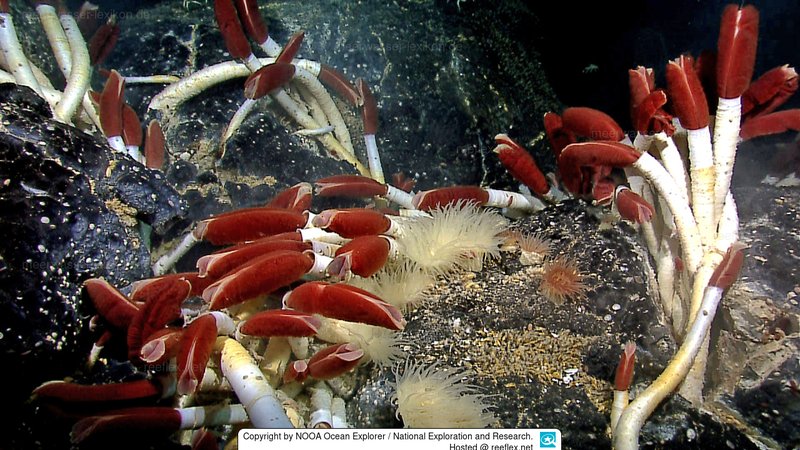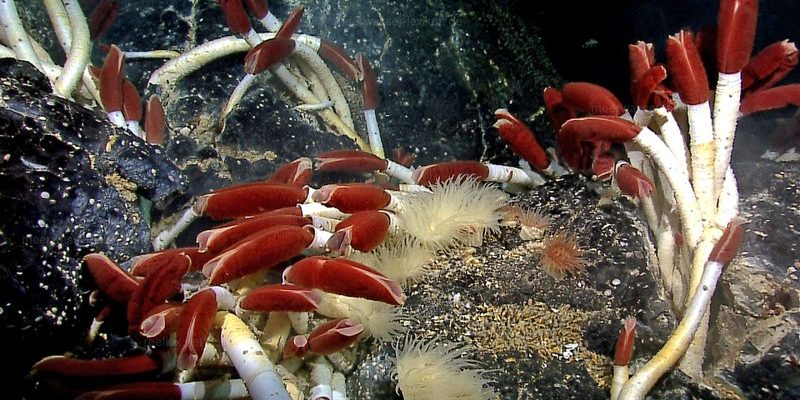
Riftia pachyptila can be found near hydrothermal vents on the ocean floor, which are like natural hot springs bubbling up from the Earth’s crust. These vents are teeming with strange and beautiful life forms. The Riftia worms, with their long, colorful plumes, not only look fascinating but also play a crucial role in the ecosystem. So, let’s dive deeper and explore why these little worms are such big players in their underwater world.
What Are Riftia Pachyptila?
To really understand the importance of Riftia pachyptila, it helps to know a bit about what they are. These are large, tube-dwelling worms that can grow up to 3 feet long. Each worm lives in a hard tube made from minerals and has a striking plume that sticks out to catch nutrients from the water.
Riftia pachyptila don’t have a traditional mouth or digestive system like most animals. Instead, they rely on a special relationship with bacteria that live inside their bodies. These bacteria convert the chemicals from the hydrothermal vents—like hydrogen sulfide—into energy through a process called chemosynthesis. It’s like having a tiny power plant inside them, turning toxic gases into food!
This unique setup allows them to thrive in environments where most other life forms can’t survive. Like a chef using the most unexpected ingredients to whip up a gourmet meal, these worms flourish in conditions that most organisms would find hostile.
The Role of Riftia Pachyptila in the Ecosystem
Riftia pachyptila play several vital roles in their ecosystem, making them essential for the health of their environment. First and foremost, they serve as a keystone species. This means that they significantly impact the structure of their community. By providing a habitat and food source for various organisms, they support a diverse range of marine life.
Their tubes create homes for other small creatures, while the biomass they produce through the support of bacteria fuels the food web. Several types of fish, crustaceans, and even other worms benefit from the foundation these tube worms lay. When you think about it, they’re like the unsung heroes of the ocean floor, quietly supporting life in the shadows.
Moreover, these worms help recycle nutrients in their environment. When the tube worms die, their bodies decompose, returning valuable nutrients to the sediment. This process enriches the surrounding area, benefiting other organisms and promoting biodiversity.
Hydrothermal Vents: The Unique Habitat of Riftia Pachyptila
The habitat of Riftia pachyptila is as remarkable as the worms themselves. Hydrothermal vents are found along mid-ocean ridges, where tectonic plates pull apart. As seawater seeps into the Earth’s crust, it gets heated by magma and rises back up, releasing minerals and gases into the ocean.
This creates a unique environment with high temperatures and pressure, as well as a rich variety of chemicals. It’s a different world down there—one that feels alien compared to sunlit coral reefs. The Riftia worms are perfectly adapted to this habitat, flourishing where few organisms can survive.
Just think about it: these worms don’t rely on sunlight for energy, which most life forms do. Instead, their existence showcases an incredible example of how life can adapt to even the most extreme conditions. It’s like finding a vibrant garden growing in a place where most people would expect to see nothing but desolation.
The Impact of Climate Change on Riftia Pachyptila
Unfortunately, like many marine species, Riftia pachyptila faces threats from climate change. Changes in ocean temperatures and acidity levels can disrupt the delicate balance of their ecosystem. Higher temperatures can affect the chemosynthetic bacteria that live inside them, directly impacting the worms’ ability to thrive.
Moreover, human activities, such as deep-sea mining and pollution, pose significant risks to their habitats. Destroying hydrothermal vent ecosystems can mean losing not just the Riftia worms but also the countless other species that rely on them. Just imagine knocking down a tree in a forest; the effects ripple throughout the entire ecosystem.
Preserving these unique habitats is vital for the survival of Riftia pachyptila and the balance of marine life. It’s essential to advocate for sustainable practices and consider the long-term impact of our actions on these fragile ecosystems.
Riftia Pachyptila and Scientific Research
The study of Riftia pachyptila isn’t just fascinating; it’s also important for scientific research. Scientists are keen to understand how these organisms survive in such harsh environments. This research can provide insights into life on other planets, especially in places with extreme conditions, such as Europa, one of Jupiter’s moons.
Additionally, studying Riftia and their chemosynthetic bacteria could lead to breakthroughs in biotechnology. For instance, researchers might discover new ways to harness energy or develop eco-friendly solutions to various environmental problems. It’s amazing how a tiny worm can inspire big ideas.
By investing in research around these species, we not only learn more about them but also gain knowledge that can benefit humanity. Protecting the Riftia pachyptila and their habitats is more than just conservation; it’s about unlocking news doors in science and innovation.
Conservation Efforts for Riftia Pachyptila
Given their ecological importance, conservation efforts are crucial for Riftia pachyptila. Organizations around the world are working to study and protect hydrothermal vent ecosystems. This includes monitoring human activities that could threaten these delicate habitats and advocating for sustainable practices in ocean management.
Some projects focus on creating marine protected areas, which can help shield these fragile environments from human exploitation. By restricting activities like deep-sea mining, we can give Riftia and other marine life a chance to thrive.
Public awareness is also key. The more people understand the importance of these remarkable creatures, the more they’re likely to support conservation initiatives. Sharing information and promoting marine stewardship can be powerful tools in the fight to protect these unique ecosystems.
Riftia pachyptila may seem small and simple, but their ecological role is anything but. These extraordinary tube worms are a testament to the resilience of life and the complexity of ocean ecosystems. They provide habitat and food for many other species, recycle nutrients, and are vital for scientific research.
As we face increasing threats to our oceans, protecting the habitats and organisms like the Riftia worms is more crucial than ever. By ensuring their survival, we’re not just preserving a unique species; we’re also supporting the entire marine ecosystem. So, let’s keep talking about these incredible creatures and advocate for the health of our oceans. Together, we can make a difference!

